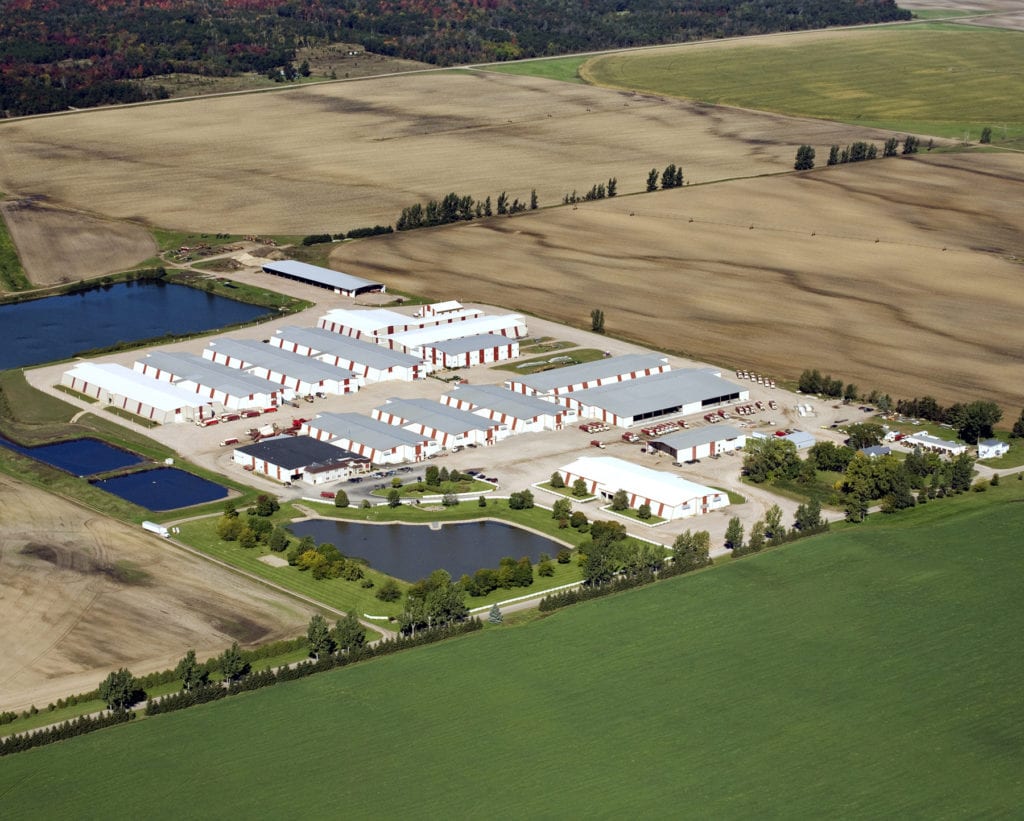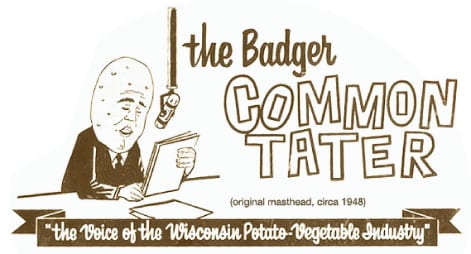
The impact of Heartland Farms, Inc., headquartered in Hancock, WI, a fifth generation, operating over 24,000 acre irrigated potato and vegetable farm specializing in chipping potatoes, vibrates across the region, employing 100 full-time and 25 part-time employees, 130 seasonal workers and contracting with several other potato growers in Portage, Waushara and Adams Counties to produce potatoes for Heartland.
Additionally, Heartland purchases millions of dollars’ worth of goods and services associated with the management of such a large operation.
Land, inputs, labor, equipment, maintenance and repairs, fuel, consultants, transportation, storage, buildings, insurance and taxes are just a few of the magnitude of expenses demanded of an agriculture enterprise of this stature.
With a heritage beginning in 1873, spearheaded by August Pavelski, great-great-grandfather to Jeremie Pavelski, current President, Heartland continues to grow beyond what August Pavelski could have ever imagined in his wildest dreams.
One of the nation’s largest suppliers of chipping potatoes to Frito-Lay, Heartland Farms also produces Snowden, Atlantic, Pike, Lamoka and other varieties and grows sweet corn, peas, green beans and soybeans, all for processing.
Jeremie Pavelski’s father, Richard, catapulted the original 80-acre farm near Amherst-Junction, into primetime when he formed a partnership with Dave Knights in 1990, forming the current legal entity. Together, Richard Pavelski and Knights grew the operation to its current size.
Knights, an innovator, was an early adapter of leading edge agricultural technologies and developed new agronomic and storage protocols for emerging Frito-Lay varieties.

Jeremie Pavelski now handles the reins of this huge enterprise, rising through the ranks while still a very young lad, initially performing mundane duties like sweeping floors. Later, he too emerged as a vanguard of new technologies, particularly with his secondary education focused on business management and computer programming and networking.
Pavelski represents what I have termed the ‘Next Generation’ because he and many other upcoming owner/operators in his age group will pave the way for the future of agriculture, using systems and equipment never even imagined in their ancestor’s time.
Like Pavelski, these owner/operators, have embraced the new wave of agriculture sophistication with a passion and adapted it to their particular interests.
Attending national and state conferences with his father as early as the seventh grade, Pavelski quickly grasped the importance of being involved in pre-legislative action, understanding that communicating growers’ needs to legislators prior to bills being formed, was the only way to help steer those bills or legislation into a compromise that benefited all stakeholders.
“Very few legislators on a local, state or federal basis, are farmers or involved in farming and thusly do not fully comprehend the consequences of any given bill or regulation on the agricultural industry,” explains Pavelski. “As the old saying goes, often if you want something done right, you have to do it yourself.”
Pavelski also immersed himself in agriculture association participations with organizations such as Wisconsin Potato & Vegetable Growers Association (WPVGA), United States Potato Board (USPB), National Potato Council (NPC), Adams County Rural and Industrial Development Commission and more.
“Many of my mentors encouraged me to become more involved in the decision making process and recommended me for leadership positions on various committees such as the co-chair of the NPC Water and Endangered Species subcommittee, when I was in my mid-twenties,” states Pavelski.
“By asking me questions or soliciting my opinion, they made me feel like an important contributor and helped form the basis of how I now treat members who are also in my age group or younger,” Pavelski said.
Given the size of Heartland’s operation and Pavelski’s immersion in the potato and vegetable industry, he is the perfect candidate to question about one of the busiest and most important times of the growers’ year: harvesting season.
Currently, Heartland’s farming interests encompass what counties of Wisconsin and what is the approximate acreage breakdown per county?
Heartland Farms operates in four counties in Wisconsin: Adams- 8,500 acres, Waushara-12,000 acres, Portage-2,500 acres and Waupaca-1,000 acres.
With so many acres in various regions, harvest time must be a logistical goliath. Can you describe for us some of the planning and processes your team employs to manage this monumental feat each year and some of the obstacles you have to overcome during harvest?
T.J. Kennedy, currently VP of Operations for Heartland Farms, provided the responses to this question.

The harvest plan starts all the way back prior to planting.
Understanding the maturity of each variety is important. We strategically plan where and when to plant our determinate varieties as well as our indeterminate varieties.
Soil types also play a big part in the overall management plan. Certain varieties perform better in sandier soils versus loamy soils.
Approximately, 15% of our volume is shipped directly out of the field to chip plants and not put into storage. This field volume is normally grown in fields less ideal for storage.
We continuously prepare for one of Mother Nature’s biggest challenges: rain, which requires a backup plan. Since we need to supply our customer with potatoes on an ongoing regular schedule, we plant potatoes on some sandy fields where we can harvest at any time even when it is raining.

Logistics is a massive piece of the harvest puzzle. With five Lencos feeding five storage lines as well as one Lenco supplying the rinse plant every day, managing trucking to drive efficiencies is a top priority. You have to juggle all six crews to ensure they are not on a long haul simultaneously. We plan weeks ahead to ensure a continuous flow of trucks for each crew. In addition, a harvester sitting idle costs the whole operation a lot of money.
Since our potato storage is located in four different counties, building a plan to guarantee that certain varieties get stored in specific storage facilities is critical. Not all potato storage facilities are created equal so we need to account for this to have our best potatoes stored in the best storages. Potato/storage management is key to shipping good quality potatoes throughout the nine months that extend to the following June.
Building the harvest plan takes time, but the real secret is in how the plan is executed. It takes a top-notch team possessing forethought and understanding of suitable harvest moistures, proper handling of potatoes and appropriate maintenance of the equipment to accomplish the goals at hand.
Since everyone loves statistics, can you provide us with some stats on Heartland’s harvest season such as projected average harvest yields/acre (per crop); manpower hours; semi-loads; gallons of fuel; number of combines, semis, hoppers or other equipment involved, average time to harvest crop/acre or your other favorite stats?

We accumulate over 300,000 team hours each year with gross payroll of over $7 million.
We ship over 8,000 semis of potatoes each year.
We have six Lenco harvesters and eleven windrowers to pull off the amazing feat of Harvest. It takes around 60 bulk trucks and drivers to bring the spuds to the storages. We purchase all of this equipment from LOCAL vendors.
It takes a lot of skilled and dedicated people to make this happen. The hard work and dedication is what really drives performance and quality.
How do harvesting operations vary between the different crops you grow and how do you manage those differences?
Actually, our teams only harvest potatoes. Typically, other operations grow and harvest necessary rotation crops on acres owned by Heartland Farms. We prefer to stick to our core competency. We will however help with custom planting and other services, if necessary.

Growing up in the Heartland operation, what aspects of harvest season do you see executed differently for the different crops now than when your father or grandfather farmed?
Our entire operation comprises many more acres than when my grandfather or even my father farmed. Our huge increase in acres over the years requires many more teams of great people, dedicated workers and managers all collaborating to accomplish our goal of delivering high quality potatoes to our customers.
All through our history, we have never lost track of how important our greatest asset, our crewmembers, are to our operation. While our overriding goal is to produce high quality potatoes for our customers, providing safety, particularly in reducing operator fatigue, is equally important.
Still, it is amazing how much technology and equipment has changed the agricultural industry, replacing human labor with substantially bigger machines operated or controlled by people or other machines, making things easier and more productive.
Storage, too, is much more sophisticated than in the past, which helps ensure that the crop stores well and that we can supply our customers’ spuds when they need them.
It staggers my imagination when I look through old photos of Grandpa and dad digging potatoes by hand

or with one-row harvesters. Reflecting on the journey they went through to get us where we are today really puts things into perspective for me.
Meanwhile, embracing emerging technologies, software and various apps will continue to allow us to work faster, save time, increase productivity and be more accurate in the field or off.
With your emphasis on getting involved in the legislative process, what possible bills/regulations, both state and federal are you tracking because of their impacts on the potato and vegetable industry overall and what do you believe those impacts to be?
First off, I never realized that getting more involved in the legislative process would end up being pretty much a full time job in itself besides the rest of the many details that are involved in running a business. The regulatory burden is getting ever more complex and frustrating.
Many people do now know where their food comes from and the hard work and dedication it takes to get the food to the stores. At any given time, about five to ten new regulations pop up that place a substantial burden on farmers, which in turn increase food costs.
I have listed below some of the major legislative concerns we continue to monitor and it gives you a pretty good idea of how enormous of a burden Agriculture carries today.
- HIGH CAPACITY WELL LEGISLATION
We all want clean and abundant water resource for all uses, not just agriculture. Some of the over-reaching regulations make it so the current crops in Wisconsin could be at risk for many growers if proper planning is not in place.
When older wells fail, it is increasingly difficult to get them reconstructed. Many people think if you are replacing a well, it is because the water is no longer there. That is not normally the case. Data shows that water levels in our region are very similar to what they have been for several years with only seasonal changes.
High capacity well users are going to need to work together to ensure this resource is available in the future and provides security to the farmers.
- IMPLEMENTS OF HUSBANDRY
This rule alone cost our farm over 300 hours of time and $40,000 in labor other costs this year. This excludes the time working with legislators and other representation
The impacts on this are high costs for permits (even though they are no-fee permits…there is a lot of time and effort that goes into making them). The amount of road miles traveled and the amount of trips it takes to accomplish a task are increasing at a rapid pace. This creates tremendous inefficiency and increases costs for no real gain.
- WATERS OF THE U.S. (WOTUS) RULES
The EPA is over-reaching by trying to make water bodies that are not “navigable” included in what is considered a ‘water of the US’.
- BIOTECH RULES
- ENDANGERED SPECIES ACT
- NUTRIENT MANAGEMENT LAWS
If the elements of these laws are not carefully considered, the amount of nutrients needed to grow a crop versus what is actually allowed could be impacted and production will suffer dramatically.
- TAX ISSUES
Too numerous to detail.
- AFFORDABLE CARE ACT
- DATA PRIVACY LEGISLATION
- INTERNET REGULATIONS
- WIC AND FOOD ASSISTANCE LEGISLATION
- IMMIGRATION
- DRONE LEGISLATION
Drones, a new and emerging technology, offer potentially major benefit to farmers. Garnering near real-time analysis of a field through imagery and software will help reduce the amount of inputs (water, fertilizers, crop protectants, etc.) needed to produce a healthy crop. New legislation is needed to keep up with the technology and provide a way for Agriculture to use drones safely without being so restrictive that drones are rendered basically useless.
- FARM BILL LEGISLATION
Always an ongoing headache because each Farm Bill usually legislates redistributed funding, escalating restrictions and new regulations that hamper the business of Agriculture and tie the hands of producers.
Finally, what would you say to growers of all generations regarding getting involved in championing their industry and participating in legislative efforts or associations?
I highly recommend growers of all ages get involved in the process. It takes time and dedication but farmers are becoming fewer and farther between. Since we represent the less than 1% of the population that provides food for the rest of the world, we need to ensure our small numbers carry a lot of weight.
A saying passed down from generation to generation in my family is “If you are not at the table, you are probably on the menu.” I think that is even truer today. If you are not involved, people will make decisions regarding you or your business even when they do not realize the full consequences of their actions.
If not, we will all wake up one day with not enough food on the table because people unaware of what it takes to produce a global supply or even just a nationwide supply of food, legislated the farmer out of business.
It is ironic that everyone has an emotional connection to the vision of a small farm and yet one of the main reasons that small farms keep reducing in number is because they cannot deal with the regulatory burdens. An unrealistic, utopian viewpoint of what farming should be has replaced the common sense and reality of what it really takes to feed the world.


